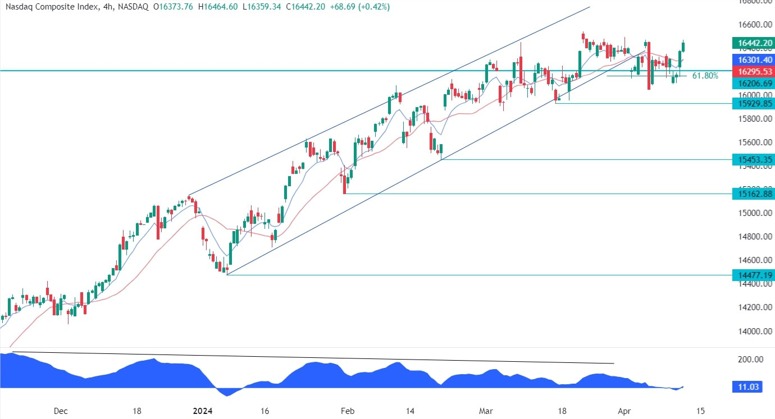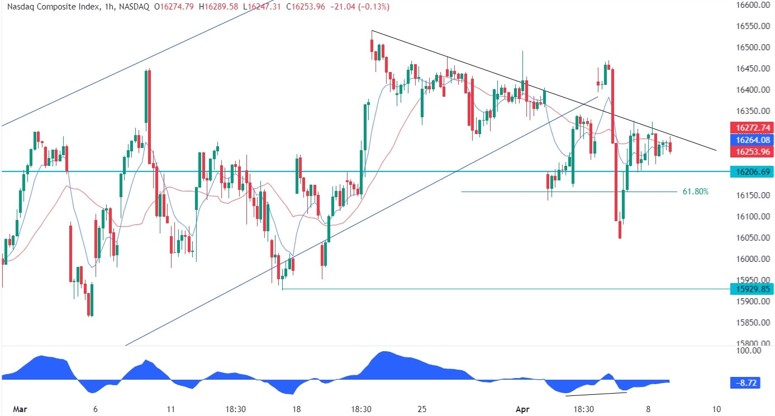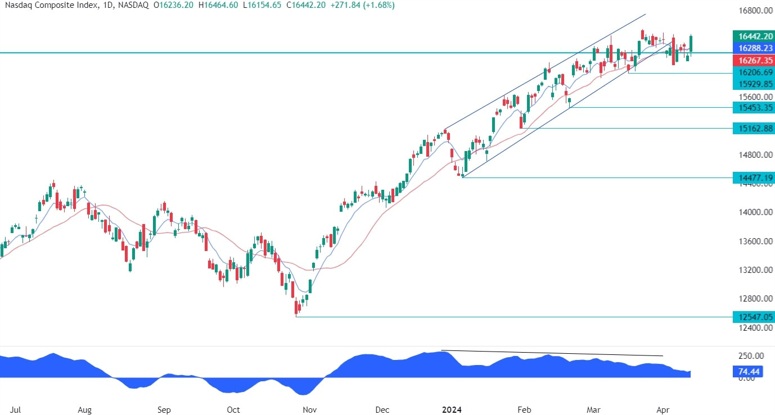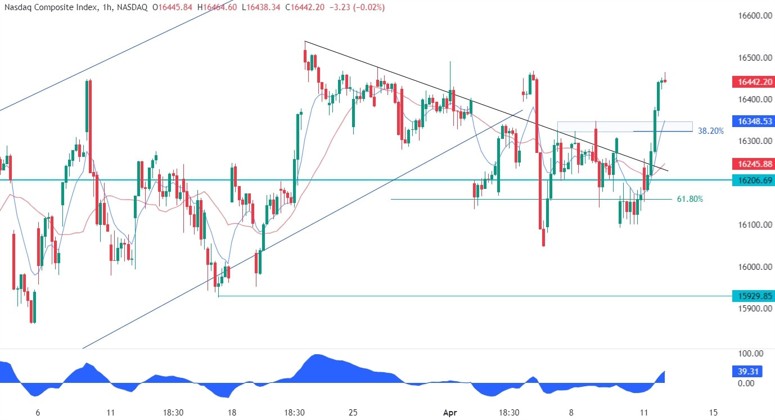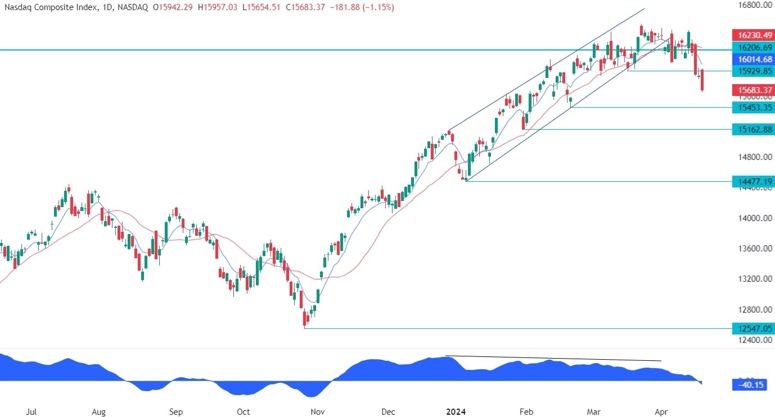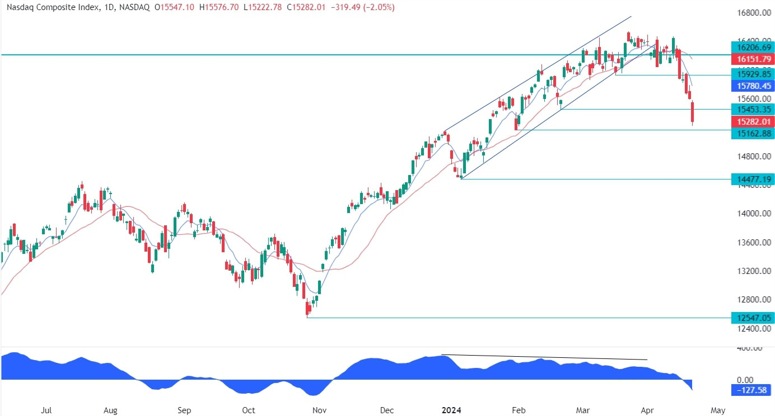NASDAQ Composite
Parent Index
NA
Indices informations
Listed Exchanges
Related Instuments
| E-mini NASDAQ Compososite |
Sector Represented
Indices
- BSE SENSEX
- CAC 40
- CBOE NASDAQ-100 Volatility Index (VXN)
- CBOE Volatility Index (VIX)
- China50-FTSE China A50 Index
- DAX
- DAX PERFORMANCE-INDEX-GDAXI
- DE40-Germany 40 Index DAX
- Dollar Index USDX-DXY-DX-Dixie
- Dow Jones Industrial Average-DJIA
- EURO STOXX 50 SX5E
- FTSE 100 Index-UK100 Index
- Germany 30
- Hang Seng Index
- IBEX 35-Spain 35
- NASDAQ Composite
- NASDAQ-100
- Nikkei 225
- Russell 2000 Index
- S&P/ASX 200
- Singapore Blue Chip Index-STI
- Swiss Market Index (SMI) Switzerland Blue Chip Index
- TecDax Price Index
- TECHDE30-Germany Tech 30 Index
- US Tech 100 Index UT100
- US2000-US Small Cap 2000 Index
- US30-US Wall Street 30 Index
- US30M- US Wall Street 30 Index M
- US500-S&P 500 (GSPC, INX, SPX)
- US500-US SPX 500 Index
- US500M-S&P 500 Mini
- All Ordinaries
- Amsterdam Exchange Index AEX index
- ATX-Austrian Traded Index (ATX)
- BEL 20
- BELEX15
- BIRS
- BIST-Borsa Istanbul
- CROBEX
- EGX 30 Index Egypts Leading Stock Market Index
- FTSE All-Share Index
- FTSE Bursa Malaysia Index-KLCI Index
- FTSE MIB-FTSE MIB 40
- Índice Bursátil Caracas (IBC)
- Índice Bursátil de Capitalización-The General Index
- Indice de Precios y Cotizaciones
- KOSPI
- KSE 100 Index
- MDAX
- MERVAL
- MICEX-The MOEX Russia Index
- OBX Index
- OMX Copenhagen 20 (OMXC20)
- OMX Helsinki 25 (OMXH25)
- OMX Stockholm 30 (OMXS30)
- PSE Index (PSEi)
- PSI20-PSI-20
- S&P/NZX 50 Index
- S&P/TSX 60
- S&P/TSX Composite Index
- S&P/TSX Venture Composite Index
- SOFIX
- SSE Composite Index (上证综指) Shanghai Composite Index
- Straits Times Index (STI)
- SZSE Component Index (深证成指)
- TA-125 Tel Aviv 125 Index
- Taiwan Capitalization Weighted Stock Index (TAIEX)
- The Indice de Precio Selectivo de Acciones- IPC
- CBOE NASDAQ-100 BuyWrite Index (BXN)
- Hang Seng China H-Financials Index
- IBOVESPA-The Bovespa Index-Brazil Stock Exchange Index
- NASDAQ Financial-100
- SDAX – Small cap
- TecDAX
- aaa
- Amex Gold BUGS Index
- Amex Oil Index
- AScX index – Small cap
- ASE Weighted Index
- Athex 20
- Barrons 400 Index
- BELEXline
- BET-10
- BSE DCI
- BSE FCI
- BUMIX – Mid cap
- BUX – Large cap
- CA60-Canada 60 Index
- CAC All Share
- CAC All-Tradable
- CAC Large 60
- CAC Mid & Small
- CAC Mid 60
- CAC Next 20
- CAC Small
- Capital Markets Index
- CASPI
- CBOE DJIA BuyWrite Index (BXD)
- CBOE S&P 500 BuyWrite Index (BXM)
- CBV Index
- CBV Real Estate Index
- CECEEUR
- Central European Blue Chip Index – Regional large cap
- ChinaH-Hong Kong China H-shares Index
- COLCAP
- Colombo Stock Exchange Sector indices (CSE Sectors)
- CROBIS
- CSC X
- CSE 30
- CSE50
- CSI
- CSI 100 Index (中证100指数)
- CSI 300 Index (沪深300指数)
- Dow Jones Global Titans 50
- Dow Jones Transportation Average
- Dow Jones Utility Average
- DSE
- DSEX
- DSM200
- EGX 100 Index
- EGX 50 Index
- EGX 70 Index
- ERS10
- FIRS
- FT 30 Index
- FTSE 350 Index
- FTSE AIM All-Share Index
- FTSE AIM UK 50 Index
- FTSE All-World index series
- FTSE Fledgling Index
- FTSE Italia Mid Cap
- FTSE MID 250 Index
- FTSE SmallCap Index
- FTSE techMark Index
- FTSE/Athex Large Cap
- FTSE/JSE All Share Index
- FTSE/JSE Top 40 Index
- FTSEurofirst 300 Index
- FTSEurofirst Euro Supersector Indices
- GSE All-Share Index
- Hang Seng China Enterprises Index
- Hang Seng China-Affiliated Corporations Index
- HK50
- IDX Composite
- IGBC
- IPSA
- ISEQ 20-The Ireland Overall Stock Exchange Index-ISEQ20
- IT40-Italy 40 Index
- Jakarta Islamic Index (JII)
- Jamaica Stock Exchange (JSE)
- KASE
- KMI 30 Index
- KOSDAQ
- KSE All Share Index
- KSE-30 Index
- Kuala Lumpur Composite Index
- LASI
- LQ-45
- LuxX Index – Luxembourg Stock Exchange
- MADEX index
- Madrid Stock Exchange General Index
- MASI index
- MESDAQ
- MIDDE50-Germany Mid 50 Index
- MIDDE60-Germany Mid 60 Index
- Milanka Price Index (MPI)
- MSCI EAFE
- MSCI GCC
- MSCI Hong Kong Index
- MSCI World
- MSM-30
- NEPSE Index – Nepal Stock Exchange
- NETH25
- NIFTY 100 LOW VOLATILITY 30
- NIFTY 200
- NIFTY ALPHA 50
- NIFTY BANK
- NIFTY CPSE
- NIFTY ENERGY
- NIFTY FINANCE
- NIFTY FMCG
- NIFTY INDIA CONSUMPTION
- NIFTY INFRA
- NIFTY IT
- NIFTY MEDIA
- NIFTY METAL
- NIFTY MIDCAP 100
- NIFTY MIDCAP 50
- NIFTY MIDCAP LIQUID 15
- NIFTY MIDSMALLCAP 400
- NIFTY MNC
- NIFTY Next 50
- NIFTY PHARMA
- NIFTY PSE
- NIFTY PSU BANK
- NIFTY PVT BANK
- NIFTY REALTY
- NIFTY SERV SECTOR
- NIFTY SMALLCAP 100
- NIFTY SMALLCAP 250
- NIFTY SMALLCAP 50
- NIFTY100 EQUAL WEIGHT
- NIFTY100 LIQUID 15
- NIFTY200 QUALITY 30
- NIFTY50 EQUAL WEIGHT
- Nor25-Norway 25 Index
- NSE 30 Index
- NSE All Share Index
- NSE NIFTY 50
- NYSC Arca Major Market Index
- NYSE American Composite Index
- OMX Iceland 15 (discontinued)
- OMX Iceland 6
- OMX Stockholm PI (OMXSPI)
- OMX Vilnius (OMXV)
- OTCM QX ADR 30 Index
- Palisades Water Index (ZWI)
- PFTS index
- Philadelphia Gold and Silver Index
- PHLX Semiconductor Sector
- PSE All Shares Index
- PSE Financials Index
- PSE Mining and Oil Index
- PSI/GERAL
- PX Index
- RTS Index (RTSI)
- Russell 1000
- Russell 2500
- Russell 3000
- Russell MidCap
- Russell Small Cap Completeness
- S&P 100
- S&P 1500
- S&P Asia 50
- S&P BSE 500
- S&P Europe 350
- S&P Global 100
- S&P Global 1200
- S&P Latin America 40
- S&P MidCap 400
- S&P MidCap 400/BARRA Growth
- S&P MidCap 400/BARRA Value
- S&P SmallCap 600
- S&P SmallCap 600/BARRA Growth
- S&P SmallCap 600/BARRA Value
- S&P Vietnam 10 Index
- S&P/ASX 20
- S&P/ASX 300
- S&P/ASX 50
- SA40-South Africa 40 Index
- SBF 120
- SE30-Sweden 30 Index
- SET Index
- SET100 Index
- SET50 Index
- Slovak Share Index
- SMI Expanded
- SMI MID
- SPBLPGPT
- SSE 180 Index (上证180指数)
- SSE 50 Index (上证50指数)
- STOXX Europe 600
- SWI20-Switzerland 20 Index
- Swiss Leader Index (SLI)
- Swiss Performance Index (SPI)
- SZSE 100 Index (深证100指数)
- SZSE 200 Index (深证200指数)
- SZSE 300 Index (深证300指数)
- TA-35 Index
- TA-90
- Tadawul
- TEDPIX
- TEPIX
- The Global Dow
- The GSE Composite Index.
- THETAUSD Theta Network Token vs US Dollar
- TOPIX
- Trinidad and Tobago Stock Exchange (TTSE)
- UBS 100 Index
- Value Line Composite Index
- VN Index
- WIG-Warszawski Indeks Giełdowy
- WIG30
- Wilshire 4500
- Wilshire 5000
- Zimbabwe Industrial Index
- Zimbabwe Mining Index
Nasdaq Composite Index
The Nasdaq Composite Index is a stock market index that represents the performance of more than 3,000 companies listed on the Nasdaq Stock Market. It is one of the major stock market indices in the United States and widely followed by investors and traders around the world.
Overview
The Nasdaq Composite is a market-capitalization-weighted index, meaning that the larger companies have a greater impact on its value. It includes companies from various sectors such as technology, healthcare, consumer goods, finance, and more, making it a diversified index that reflects the overall performance of the tech-heavy Nasdaq exchange.
The index was launched in 1971 and has since become an important benchmark for the technology sector and growth-oriented companies. Many well-known and influential companies are listed on the Nasdaq Composite, including tech giants like Apple, Microsoft, Amazon, Alphabet (Google), and Facebook, among others.
Calculation and Components
The Nasdaq Composite Index is calculated using a market capitalization methodology. This means that each company’s weight in the index is proportional to its market value. The formula used for calculating the index is as follows:
Index Value = (Sum of market caps of all index components) / (Divisor)
The divisor is a proprietary number that is periodically adjusted to maintain continuity in the index value over time, considering factors like spin-offs, stock splits, and other corporate actions.
The components of the Nasdaq Composite can change over time as companies get added or removed based on certain criteria. The index is reviewed annually, but changes can also be made throughout the year if necessary.
Significance
The Nasdaq Composite Index is highly regarded as an indicator of the overall performance and sentiment of the technology sector and growth stocks in the US market. It is closely watched by investors, analysts, and financial professionals to gauge the health of the tech industry and the broader stock market.
Due to its heavy representation of technology companies, the Nasdaq Composite is often used as a benchmark for technology-focused investment funds, such as exchange-traded funds (ETFs) or mutual funds that track the performance of the index.
Conclusion
The Nasdaq Composite Index plays a crucial role in the financial markets, providing insight into the performance of technology companies and growth-oriented stocks. Its ability to adapt to changing market conditions and capture the leading players in the tech industry has made it a widely recognized and influential index. Investors and traders rely on the Nasdaq Composite as a valuable tool for analysis and decision-making in today’s dynamic stock market.
The Nasdaq Composite is a stock market index that represents the performance of over 3,000 common equities listed on the Nasdaq stock exchange. It is widely regarded as an indicator of the health and performance of the technology sector and the overall stock market in the United States.
Key Data
Here are some key data points related to the Nasdaq Composite:
- Ticker Symbol: The ticker symbol for the Nasdaq Composite is .IXIC.
- Inception Date: The index was first calculated on February 5, 1971.
- Weighting Methodology: The Nasdaq Composite is a market capitalization-weighted index, which means that companies with larger market capitalizations have a greater impact on the index’s performance.
- Components: As of [insert date], the Nasdaq Composite consists of more than 3,000 individual stocks from various sectors including technology, healthcare, consumer discretionary, and more.
- Performance: The Nasdaq Composite has historically outperformed other major indices, driven by the strong performance of technology stocks. However, it is important to note that past performance is not indicative of future results.
- Listing Requirements: To be included in the Nasdaq Composite, a company must meet certain listing requirements set by the exchange, such as minimum share price, market value, and trading volume thresholds.
- Global Reach: While primarily comprising U.S.-based companies, the Nasdaq Composite also includes international companies that are listed on the Nasdaq stock exchange.
Overall, the Nasdaq Composite provides investors with a comprehensive view of the performance of the technology sector and the broader stock market. Its key data points help investors understand the composition, performance, and trends within this important index.
Nasdaq Composite Index Composition
The Nasdaq Composite is a stock market index that includes all the common stocks and similar securities listed on the Nasdaq stock market. It is one of the most widely followed stock indexes in the world, representing the performance of technology and growth companies.
The composition of the Nasdaq Composite Index is determined by the types of companies listed on the Nasdaq stock exchange. Unlike other major indices like the S&P 500 or Dow Jones Industrial Average, the Nasdaq Composite primarily consists of technology-oriented companies, which are typically more growth-oriented and innovative.
Here are some key components that make up the Nasdaq Composite:
1. Technology Companies
Technology companies form a significant part of the Nasdaq Composite Index. These include well-known giants like Apple, Microsoft, Amazon, Alphabet (Google), Facebook, Intel, Cisco Systems, and many more. These companies drive innovation and play a crucial role in shaping the future of the global economy.
2. Biotechnology Companies
The Nasdaq Composite also includes a substantial number of biotechnology companies. These firms are engaged in research, development, and commercialization of medical products, drugs, and therapies. Notable biotech companies in the index include Amgen, Gilead Sciences, and Moderna, among others.
3. Consumer Discretionary Companies
The consumer discretionary sector encompasses companies that produce non-essential goods and services, such as retail, media, leisure, and entertainment. Some prominent consumer discretionary companies in the Nasdaq Composite Index are Amazon, Netflix, Tesla, Starbucks, and Nike.
4. Communication Services Companies
The Nasdaq Composite also includes communication services companies involved in various forms of communication, including telecommunications, media, and entertainment. Notable companies in this sector include Comcast, Verizon Communications, and AT&T.
5. Other Sectors
Besides the aforementioned sectors, the index also consists of companies from sectors like healthcare, financials, industrials, and more. These companies add diversification to the index and contribute to its overall performance.
It’s important to note that the composition of the Nasdaq Composite Index is periodically reviewed and updated to ensure its relevance and accuracy. The index is capitalization-weighted, meaning that larger companies have a greater impact on its value.
In conclusion, the Nasdaq Composite Index is comprised of a wide range of companies from different sectors, with a strong focus on technology and growth-oriented industries. It serves as a benchmark for investors and provides insights into the performance of the broader stock market, particularly within the tech and innovation space.
Fundamental Summary
- Coming soon!!


